Imagine walking through ancient Roman streets, surrounded by timeless ruins. Volubilis Morocco is a place where history comes alive. It’s an ancient Roman city in Morocco’s heart, preserved for centuries. Here, you can see how people lived long ago.
As you explore, you’ll learn about its rich history and cultural importance. It’s now a UNESCO World Heritage Site. For more on planning your visit, check out Volubilis Morocco.
Key Takeaways
- Volubilis is an ancient Roman city in Morocco, and it’s a UNESCO World Heritage Site.
- The city was founded in the 3rd century BC and was a key trade and commerce center in the Roman Empire.
- Visitors can explore ruins, including well-preserved buildings, mosaics, and artifacts.
- Volubilis is about 22 miles north of Meknes, and the admission fee is 70 dirhams.
- The site has remarkably well-preserved tile mosaics, mainly in the wealthier areas.
- Official guides are available for hire at the entrance for 120 dirhams. The site is open every day from sunrise to sunset.
Introduction to Volubilis Morocco
Volubilis is an ancient Roman city in Morocco. It’s a UNESCO World Heritage Site. Visitors can take guided tours to see its ruins and learn about its history.
With its preserved ruins, mosaics, and artifacts, Volubilis is a top spot for history and architecture fans.
Exploring Volubilis is best with guided tours Volubilis. They offer a deeper look into the city’s past. You can also wander on your own, finding many things to do in Volubilis Morocco.
Highlights include the mosaics, ancient buildings, and views of the countryside. Volubilis is a unique spot with history and culture for all.
Location and Accessibility
Volubilis is close to Meknes, making it easy to reach by car or taxi. It’s about 30 kilometers north of Meknes and 50 kilometers west of Fez. The best time to visit Volubilis is in spring and autumn. The weather is mild and pleasant during these months.
How to Get to Volubilis from Major Cities
To reach Volubilis, you can take a train or petit taxi to Moulay Idriss. Then, take a taxi to the site. The drive from Meknes to Volubilis is about 30-40 minutes. For travel tips Volubilis Morocco, consider hiring a guide. They can share the site’s history and significance.
Best Time to Visit Volubilis
The best time to visit Volubilis is in spring (March to May) or fall (September to November). Temperatures are in the mid to high 20s Celsius (70s to low 80s Fahrenheit). Summer can be very hot, over 35°C (95°F). Plan your trip to enjoy a comfortable and informative visit.
Architectural Highlights of Volubilis
Volubilis is a historical site filled with well-preserved buildings. These structures show the city’s rich history and cultural importance. The city’s architecture reflects its role in the Roman Empire, with many buildings still standing today.
Visitors to Volubilis can see many architectural wonders. These include the basilica, the triumphal arch, and several mosaics. Each of these highlights offers a glimpse into the city’s past.
The city’s buildings reflect its Roman history. The basilica is a Roman masterpiece that shows the city’s architectural skills. The triumphal arch symbolizes the city’s glory in the Roman Empire.
The mosaics found throughout the city are also a testament to ancient Rome’s artistry. They depict scenes from everyday life, showcasing the creativity of the time.
The Basilica: A Roman Masterpiece
The basilica is one of Volubilis’ most impressive buildings. It features large columns and intricate carvings. This building shows the city’s wealth and importance in the Roman Empire.
The Triumphal Arch: Symbol of Glory
The triumphal arch is a symbol of the city’s glory. It stands tall in the city, showcasing its importance in the Roman Empire. Its architecture is still impressive today.
Mosaics: Artistry of Ancient Rome
The mosaics in Volubilis showcase ancient Rome’s artistry. They depict scenes from everyday life, including animals, plants, and people. These mosaics are well-preserved and a must-see for visitors.
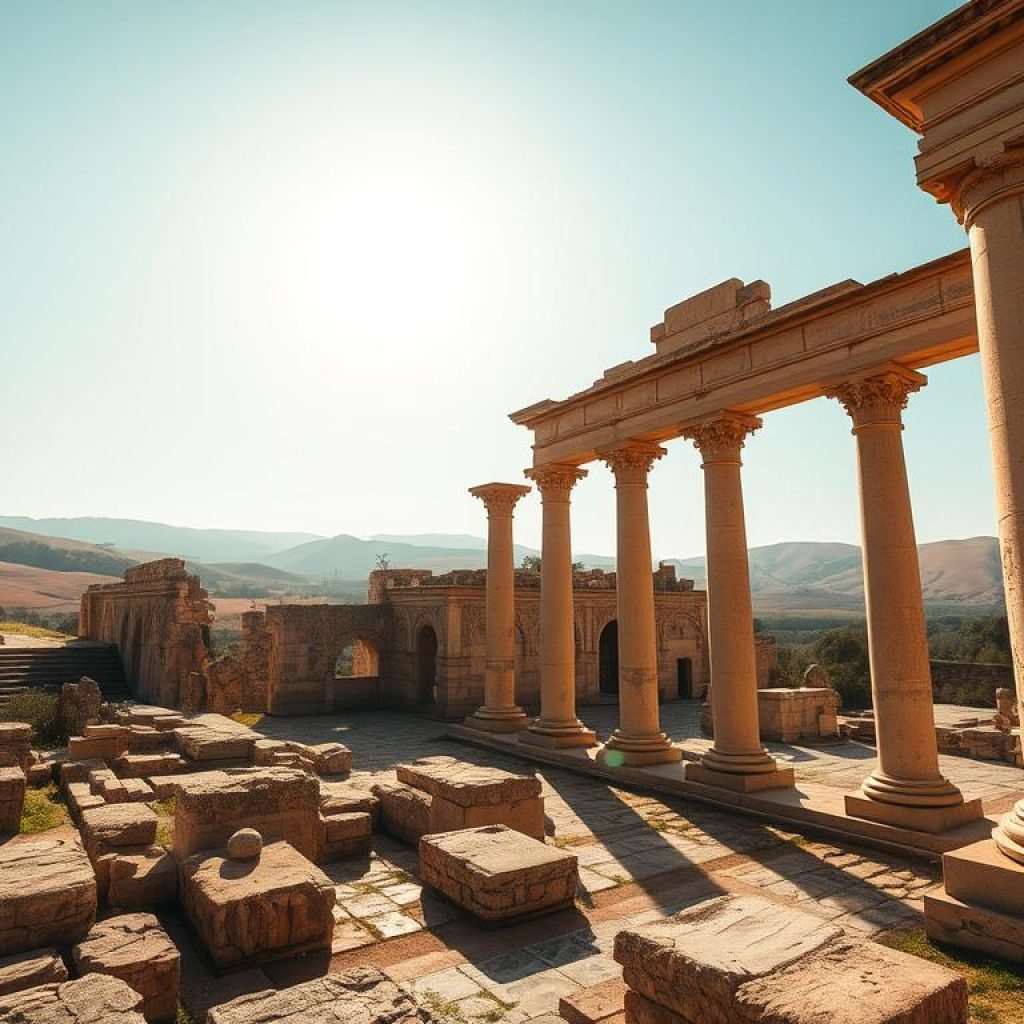
The architectural highlights of Volubilis are a testament to the city’s rich history and cultural significance. As a UNESCO World Heritage Site, Volubilis is an important part of our cultural heritage. Its architecture is still studied and admired today.
UNESCO World Heritage Status
Volubilis, a site of immense historical significance, was designated as a UNESCO World Heritage Site in 1997. This recognition has played a crucial role in preserving the site and protecting it from damage and degradation. As a UNESCO World Heritage Site Volubilis, it attracts a significant number of visitors each year, with approximately 100,000 visitors annually. The site’s entrance fee, which is 10 dirhams, is a small price to pay for the opportunity to explore the ancient ruins.
The UNESCO World Heritage Status has had a profound impact on preservation efforts, ensuring that the site is protected for future generations. Visitors to Volubilis can learn more about the criteria for selection and the impact on preservation efforts by taking guided tours or visiting the site’s museum. The site’s mosaics, which have lasted for over 2,000 years, are a testament to the ingenuity and craftsmanship of the ancient Romans.
Criteria for Selection
The selection criteria for UNESCO World Heritage Sites are stringent, and Volubilis meets all the requirements. The site is an outstanding example of a Roman city, with its well-preserved ruins and impressive architecture. The site’s location, approximately one hour from Meknes, makes it easily accessible to visitors.
Impact on Preservation Efforts
The UNESCO World Heritage Status has had a significant impact on preservation efforts at Volubilis. The site is now protected from damage and degradation, and efforts are being made to preserve the ruins for future generations. The Volubilis Morocco entrance fee is a small contribution towards the preservation efforts, and visitors can be assured that their visit is helping to protect the site.
Visitors to Volubilis can explore the site’s many attractions, including the Basilica, the Triumphal Arch, and the impressive mosaics. With its rich history and well-preserved ruins, Volubilis is a must-visit destination for anyone interested in ancient history and culture.
| Site Information | Details |
|---|---|
| UNESCO World Heritage Status | Designated in 1997 |
| Entrance Fee | 10 dirhams |
| Number of Visitors | Approximately 100,000 annually |
Exploring the Ruins
Visitors to Volubilis can explore the ruins on their own or take guided tours. These tours offer a deeper look into the site’s history and importance. Walking through the ancient streets, you’ll see amazing architecture.
The site is open every day from 08:30 until one hour before sunset. This allows visitors to plan their day well.
Guided tours Volubilis are available in several languages. You can book them in advance or at the site’s entrance. These tours give professional insights, helping visitors understand the city’s history and significance.
Whether you explore alone or with a guide, Volubilis is a must-see. It’s perfect for those interested in history and architecture.
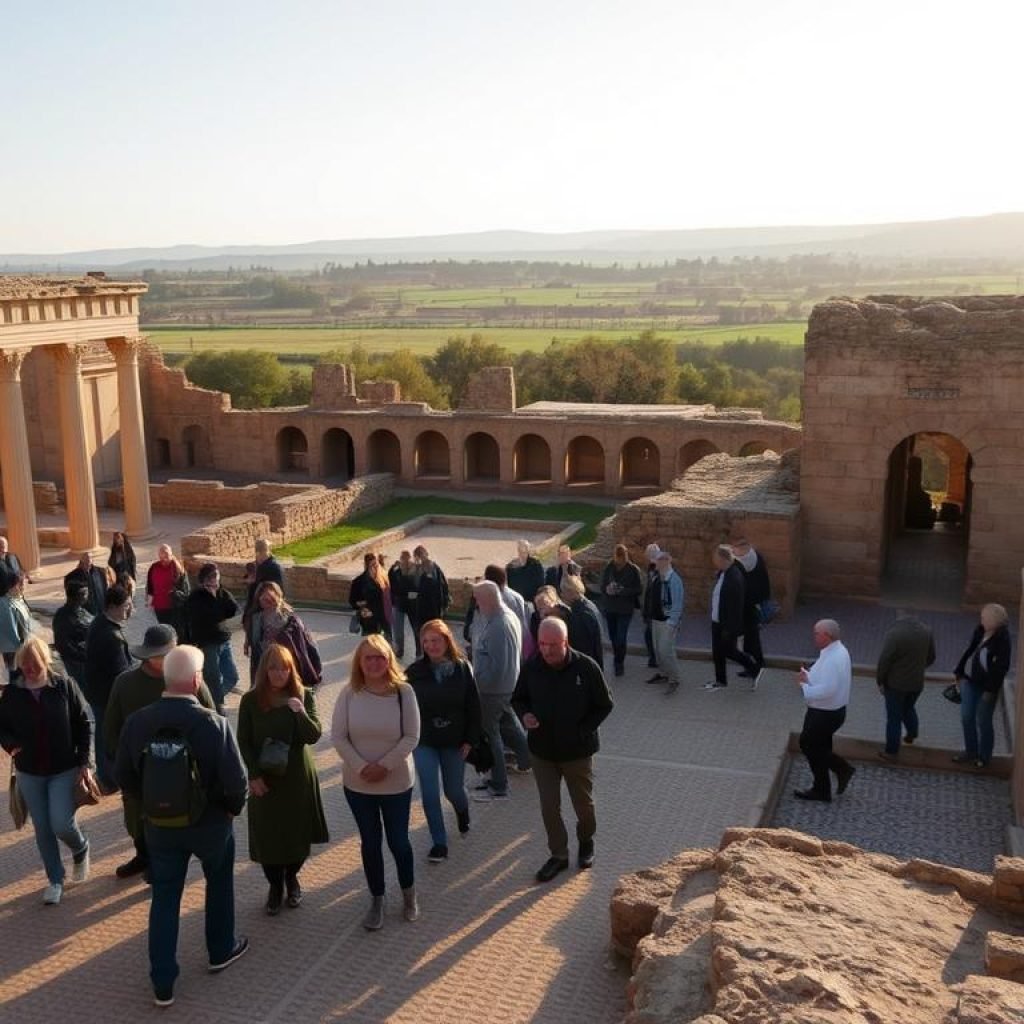
Highlights include the impressive triumphal arch and the well-preserved mosaics. The grand basilica is also a must-see. You can also explore the ancient town walls, with forty towers and eight monumental gates.
With so much to see and do, Volubilis is a top tourist spot in Morocco.
The Role of Volubilis in Ancient Society
Volubilis, a historical site in Morocco, was a key center of trade and commerce in the Roman Empire. The city’s economy thrived on agriculture, focusing on olive oil and other crops. This made Volubilis a major attraction, drawing visitors from around the world.
The city’s social structure was complex, blending Roman and indigenous cultures. It was home to merchants, farmers, and artisans. The Roman ruins of Volubilis offer a glimpse into the daily lives of its people, showcasing their skills and craftsmanship.
Economic Importance in Roman Times
During the Roman era, Volubilis’s economy was booming. The city was a major hub for trade and commerce. Olive oil production was a big part of this, contributing greatly to the city’s wealth.
Today, visitors can see the remains of the olive oil production facilities. These ruins highlight the importance of this industry in ancient times.
Social Structure and Daily Life
The social structure of Volubilis was shaped by both Roman and indigenous influences. The city’s inhabitants lived in a complex society with various social classes and occupations. From merchants to farmers, artisans to craftsmen, everyone played a crucial role in the city’s economy and daily life.
Exploring the Roman ruins of Volubilis offers a deeper understanding of the city’s social structure and daily life. It provides a unique insight into the lives of its ancient inhabitants.
Nearby Attractions
When you visit Volubilis, don’t miss out on the nearby attractions. Meknes, about 33 km north, is a must-see. It’s a city full of history, with amazing architecture and a lively culture. You can take a day trip or stay overnight to see all it has to offer.
Lixus, another Roman city, is also worth a visit. It’s perfect for learning about the region’s history. For things to do in Volubilis Morocco, check out these cities. They’ll give you a deeper look into the area’s culture and history. Remember, the best time to visit is during the right season, and plan for at least two hours to see the main sights. A guided tour can also enhance your experience.
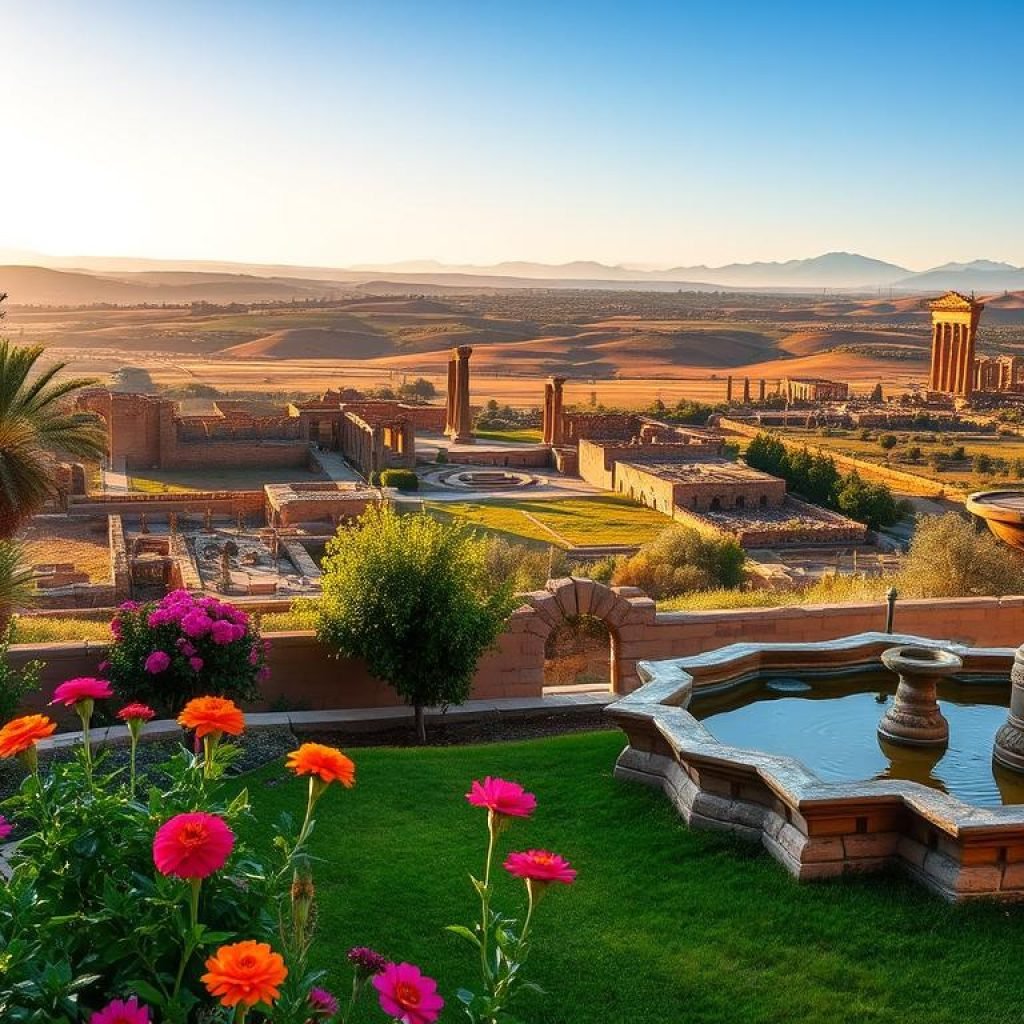
Don’t forget Moulay Idriss, just 5 km from Volubilis. And Fez, a 90-minute drive away, is another great city. Both offer unique cultural and historical experiences. They’re perfect for learning about Morocco’s rich heritage.
Practical Tips for Visitors
Planning a trip to Volubilis Morocco? Here are some travel tips to help you enjoy your visit. The entrance fee is 10 MAD, which you can pay with cash or credit card. Don’t forget to bring water, sunscreen, and comfy shoes for the uneven terrain.
Wear comfy clothes and bring a hat and sunglasses to protect from the sun. The best times to visit are morning or late afternoon. This helps you avoid the heat, which is more bearable in spring or fall. Follow these tips to fully explore the ancient ruins and history of Volubilis.
- Comfortable walking shoes
- Sunscreen and a hat
- Water and snacks
- A camera to capture the stunning views and ancient ruins
Being prepared and taking precautions will make your visit to Volubilis Morocco unforgettable. Always respect the site and its history. Take your time to soak in the unique atmosphere of this ancient Roman settlement.
Cultural Importance and Local Communities
The historical site Volubilis deeply affects the local culture. It’s a key part of the region’s heritage. As a UNESCO World Heritage Site Volubilis, it draws visitors from all over. This gives local guides and artisans a chance to share their knowledge and talents.
By exploring Moroccan culture, tourists learn about Volubilis’s importance. They see how it shapes the local community.
Local guides and artisans play a vital role in preserving Volubilis. They let visitors see the city’s history through their eyes. This offers a personal and engaging experience. Local customs and traditions are also a big part of visiting Volubilis. Many visitors join in traditional activities and workshops.
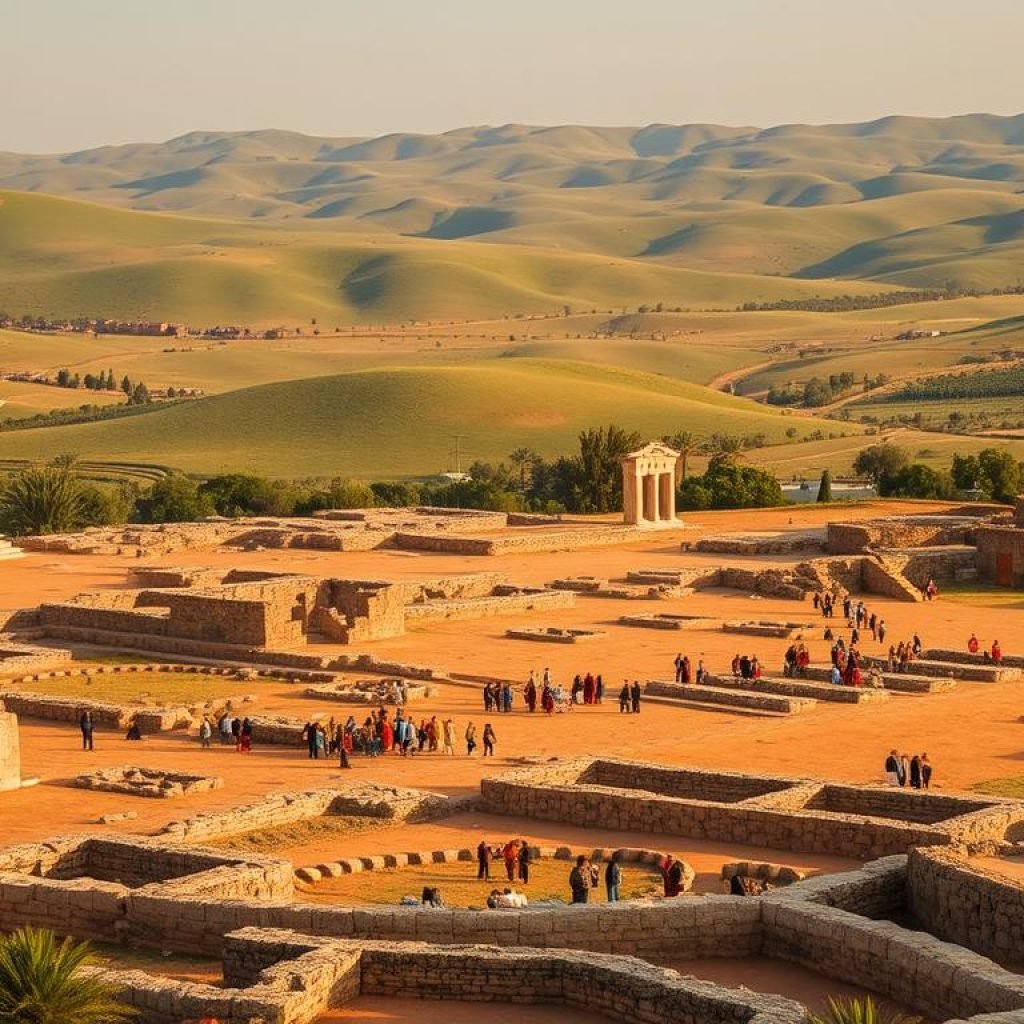
- Guided tours led by local experts
- Workshops and classes on traditional crafts and skills
- Visits to local markets and shops selling traditional goods
Supporting local guides and artisans helps preserve Volubilis’s cultural heritage. It also boosts the local economy. As a historical site, it’s crucial to protect it for future generations.
Conservation Efforts and Challenges
The UNESCO World Heritage Site Volubilis is facing many challenges, despite being a top tourist spot in Morocco. With about 200,000 visitors each year, it’s hard to keep the site in good shape. The entrance fee helps, but it’s not enough to solve all problems.
Restoring the Roman ruins, protecting the mosaics, and keeping the site safe are key tasks. The site spans 44 hectares, with a third of the Roman city uncovered since the 1900s. It’s known for its 55 olive-oil presses, showing its role in ancient Roman economy.
From 2001 to 2005, a project restored the early Islamic Bath at Volubilis. It was a team effort with the University College of London and the World Monument Funds. The goal was to uncover areas, plan site management, and create a system for upkeep.
- Four seasons of fieldwork were done from 2018 to 2022 at medieval Walila (Roman Volubilis).
- Excavations from 2000 to 2005 found houses from the 7th-9th centuries in the southern sector.
- The site has a new settlement with at least four complexes around patios, from the late 8th to early 9th centuries.
Even with these efforts, Volubilis still faces environmental threats like erosion and pollution. These dangers can harm the site’s preservation. The condition of mosaics and walls has changed over time due to factors like temperature and biological attacks.
Conclusion: The Legacy of Volubilis
The legacy of Volubilis, the UNESCO World Heritage site, is a testament to Morocco’s rich culture. This Roman city, once a bustling center, shows the mix of Moroccan, Berber, and Roman cultures. It has shaped Morocco’s history.
Volubilis thrived under Roman rule starting in the first century BC. It was a key spot for the Roman Empire. Excavations have uncovered its beauty, like the Triumphal Arch and the detailed mosaics in the Basilica.
Volubilis is a key part of North Africa’s Roman history. It draws visitors with its ruins and cultural lessons. Efforts to preserve it tackle environmental issues and tourism, keeping it open for future visitors. Visiting Volubilis is essential for anyone wanting to grasp Moroccan culture and its ties to ancient Rome.


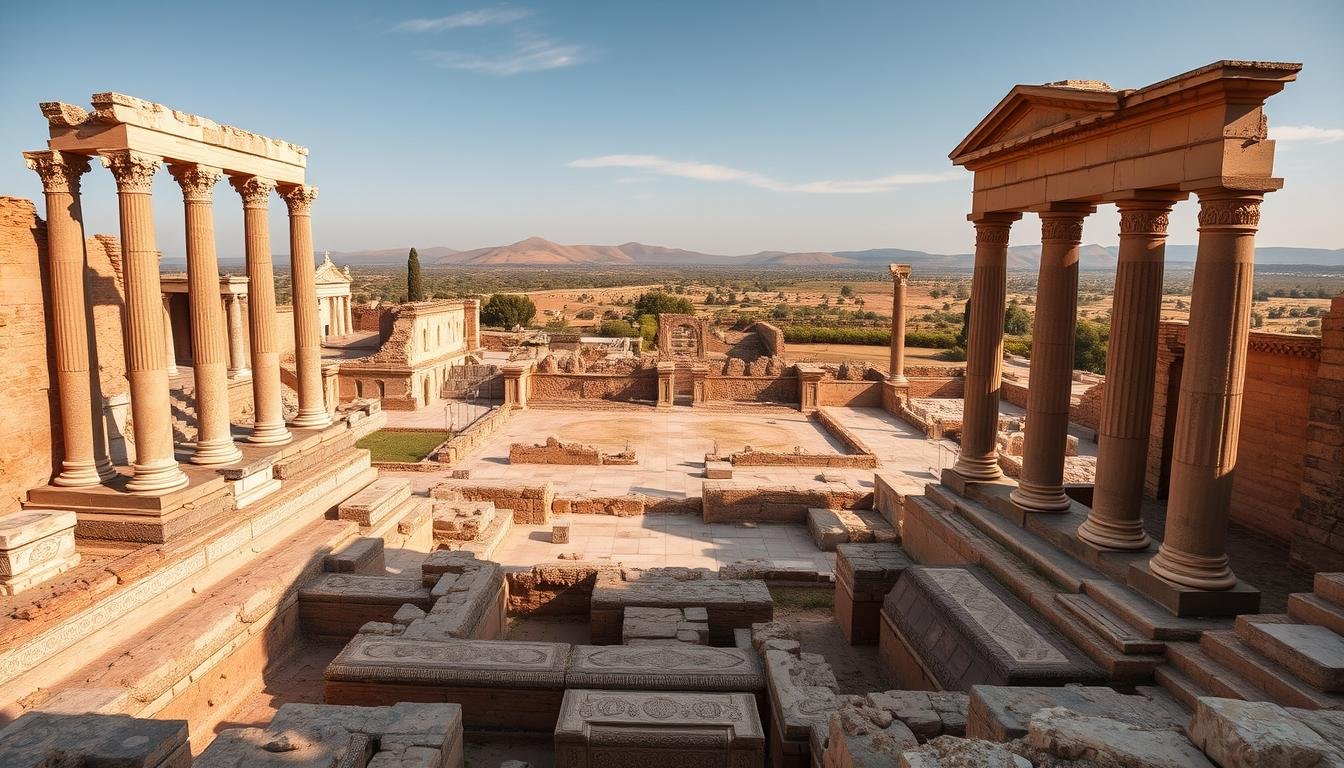

Comment (0)